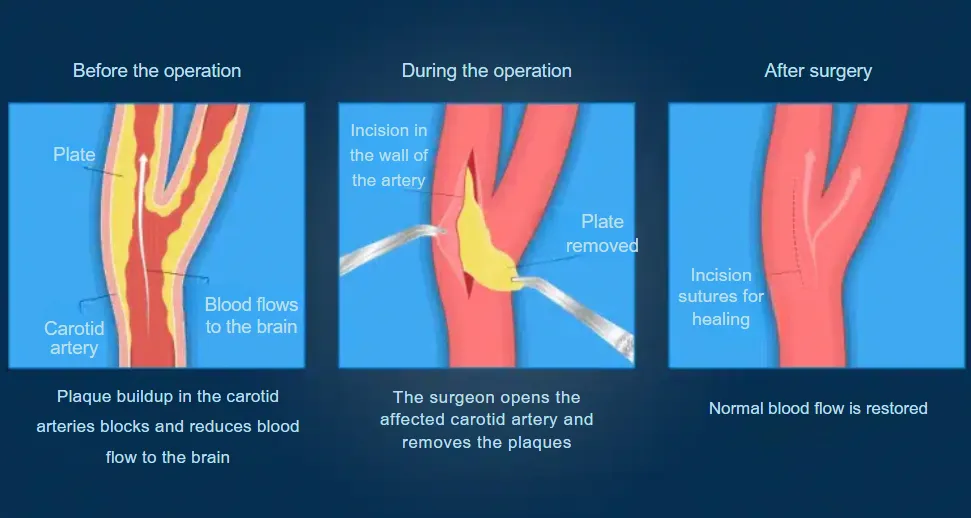Carotid arteries are essential for delivering oxygen-rich blood to the brain. When these arteries become blocked, the risk of stroke increases significantly. Carotid artery surgery is a vital procedure to remove such blockages and restore normal blood flow. Recognizing symptoms of carotid artery disease such as difficulty speaking or numbness is crucial, as timely treatment can prevent serious complications.
Adopting a healthy lifestyle plays a major role in stroke prevention. In some cases, carotid stenting can serve as a minimally invasive alternative to open vascular surgery. This approach helps maintain artery function and ensures adequate cerebral blood flow.
A blockage occurs when plaque, composed of fat, cholesterol, and calcium, builds up inside the artery walls. This narrowing, called stenosis, can restrict blood flow. If fragments of plaque break off, they may travel to smaller brain arteries and cause an embolism or even a stroke if the narrowing is severe.
What Is Carotid Artery Surgery?
When a carotid artery is narrowed or blocked, your doctor may recommend a carotid endarterectomy (CEA). This surgical procedure removes plaque deposits to restore normal blood circulation.
By clearing the blockage, CEA reduces the risk of stroke and prevents transient ischemic attacks (TIAs), which present similar symptoms to a stroke but are temporary. Maintaining an open and healthy carotid artery is essential for protecting brain function.
When Is Carotid Artery Surgery Recommended?
Your doctor may recommend carotid artery surgery if:
- You have already experienced a stroke;
- You have experienced a TIA;
- You have severe carotid artery narrowing (greater than 70 percent) that is not completely blocked.
Preparing for Carotid Artery Surgery
Before surgery, your doctor will carry out a series of diagnostic tests to assess the condition of your arteries. These may include imaging studies to determine the exact location and extent of the blockage.
What Happens During Carotid Artery Surgery?
Carotid artery surgery typically takes several hours and is performed in a hospital setting. You will be given general anesthesia, although local anesthesia may sometimes be used to numb the neck area.
The surgeon makes an incision in the neck to access the carotid artery. Blood flow through the artery is temporarily stopped to allow safe removal of the blockage. Blood continues to flow to the brain through the other carotid artery, and in some cases, a temporary shunt is inserted to redirect blood during the procedure.
Once the plaque is removed, the artery is carefully stitched closed, and the incision is sutured. This process ensures a safe and effective outcome.

Recovery After Carotid Artery Surgery
Following the procedure, you will usually stay in the hospital for 24 hours for monitoring. This helps the medical team detect and address any complications, such as bleeding or reduced blood flow to the brain, which could increase the risk of stroke.
In the days after surgery, you may notice mild pain, swelling, numbness, or bruising in the neck. Difficulty swallowing should be reported to your doctor promptly for assessment and treatment.
Avoid heavy lifting, strenuous exercise, and driving for up to two weeks after surgery. Your doctor will let you know when it is safe to resume normal activities. Adhering to these guidelines is critical for proper healing.
CEA, a Safe Procedure
Carotid endarterectomy is widely regarded as a safe and effective method for significantly lowering stroke risk in patients with carotid artery disease.
Alternatives to Carotid Artery Surgery: Carotid Stenting
Carotid stenting is another treatment option for patients who may not be suitable candidates for open surgery. This procedure involves inserting a small mesh tube, called a stent, into the artery. The stent is expanded with a balloon to hold the artery open and improve blood flow.
Your doctor will determine whether stenting or endarterectomy is the most appropriate approach for your condition. Find out more here.
Can Carotid Artery Disease Be Prevented?
Reducing the risk of carotid artery disease and stroke starts with healthy lifestyle habits. Important steps include:
- Quitting smoking;
- Reducing cholesterol and saturated fat intake;
- Exercising regularly;
- Limiting alcohol consumption;
- Maintaining a healthy body weight.
Routine check-ups and vascular assessments are important, particularly if you have risk factors or a family history of vascular disease. Promptly addressing early symptoms can make a significant difference in long-term outcomes.
Why Choose VenArt Clinic for Carotid Artery Surgery?
At VenArt Clinic, our vascular surgeons have decades of experience in carotid endarterectomy and carotid stenting, having trained and worked in leading medical centers in Europe and the United States.
If surgery is not the best option for your case, we will recommend alternative treatments that are tailored to your individual needs.
Contact us to schedule a consultation and learn more about your treatment options.
Medical Consultant: Prof. Dr. Jérôme Cau











